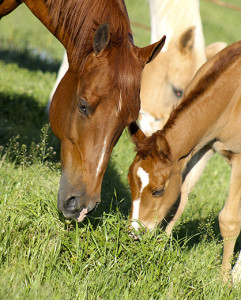Feeding Your Horse to PREVENT Ulcers
By: Dr. Juliet Getty
Dr. Juliet Getty never stops urging horse owners to “feed your horse like a horse,” for the simple reason that a horse, fed according to his physiology and instincts, will be healthier. Dr. Getty often speaks about free choice forage feeding as the first line of defense against ulcers, but there is more an owner can do to protect his horse from the pain and stress of this condition.
“For many reasons,” says the Ph.D. equine nutrition expert, “a steady, constant supply of forage keeps your horse’s digestive system healthy, but it’s especially important in ulcer prevention.” Some basic anatomy knowledge reveals why: Unlike in the human, the horse’s stomach secretes acid all the time, even when empty. Chewing creates saliva, a natural antacid. If left without food, horses will chew on whatever they can, even their own manure, to neutralize the acid that is causing them physical pain and mental discomfort. And if left with absolutely nothing to chew on, the horse will commonly develop ulcers.
Horses in the wild do not get ulcers. The diet and lifestyle we impose on our horses are to blame for this disabling condition. The good news is encouraging, according to Dr. Getty, who reminds horse owners, “We have the ability to prevent ulcers through proper feeding and stress reduction.”
In addition to offering forage, free-choice, Dr. Getty suggests horse owners consider these protective feeding guidelines:
Avoid oats and other cereal grains (corn, barley, wheat, rice, etc.). Starchy feeds can lead to ulcers by stimulating stomach cells to produce more acid and encouraging acid production through bacterial fermentation. In addition, grains move through the stomach quickly, leaving an empty stomach that is vulnerable to acid.
Feed beet pulp instead of cereal grains. It has as many calories as oats without the propensity for acid production found with starch.
If you feed extra fat, choose the right type. Vegetable oils, such as soybean and corn oils, are the most popular fat sources but they promote inflammation due to their high omega 6 content. Instead, choose vegetable sources that are high in omega 3s such as flax (meal or oil) or chia seeds, to actually reduce the inflammation experienced with ulcers.
Provide high-quality protein. Legumes such as alfalfa, soybean meal, and split peas will complement the rest of the diet, offering enough amino acids (building blocks of protein) to allow for proper maintenance and healing. Plus, alfalfa hay should be offered to any horse who is prone toward developing an ulcer (such as during stall confinement) because it is an excellent buffer.
Feed the hindgut microbial population. Fermentation products and yeast feed the microbes living in the hindgut (cecum and large colon). This makes digestion more efficient and promotes B vitamin synthesis to heal the digestive tract.
Offer additional B vitamins. Stress (from pain or difficult situation) uses up B vitamins at a rapid rate. Offer a B-complex preparation that includes all 8 B-vitamins but that does not have added iron (there is plenty of iron in forage and supplementation is rarely needed).
You know what stresses your horse
An unfamiliar environment, loss of a buddy, stalling, training, travel, and performance can result in more acid production. Did you know that a horse that is moved into a stall after being used to pasture turnout is likely to develop a gastric ulcer in less than a week? Make adjustments to your horse’s lifestyle that would reduce stress. Even a horse that appears calm can have an ulcer.
The best way to avoid an ulcer is to allow your horse to be a horse
And the best way to do that is to give him pasture turnout – the more time the better. It not only gives him a steady supply of forage, but it lets him walk around, have a chance to run and buck, and visit with other horses. I realize that it is not always feasible to give your horse all the turnout he wants, but keeping hay in front of him at all times while confined will go a long way toward protecting his digestive system.
Juliet M. Getty, Ph.D. is an internationally respected, independent equine nutritionist who believes that optimizing horse health comes from understanding how the horse’s physiology and instincts determine the correct feeding and nutrition practices. She is available for private consultations and speaking engagements. Hear Dr. Getty address issues in horse nutrition at the Kirkland House Foundation in Delta, British Columbia, sponsored by “Hay…Girl!” on May 2, 2015. For more information, contact Pam Janssen at precioushaygirl@gmail.com or call 604-961-7265.
Dr. Getty’s comprehensive resource book, Feed Your Horse Like a Horse, is available at Dr. Getty’s website, www.GettyEquineNutrition.com, as well as from Amazon (www.Amazon.com) and other online book retailers. The seven separate volumes in Dr. Getty’s topic-centered “Spotlight on Equine Nutrition” series are also available at her website (where Dr. Getty offers special package pricing) and from Amazon (in print and Kindle versions) and from other online retailers. Dr. Getty’s books make ideal gifts for horse-loving friends.
Dr. Getty’s website, www.GettyEquineNutrition.com, offers a generous stock of free, useful information for the horseperson. Sign up for her free monthly newsletter, Forage for Thought; browse her library of reference articles; search her nutrition forum; and purchase recordings of her educational teleseminars. Reach Dr. Getty at gettyequinenutrition@gmail.com.











